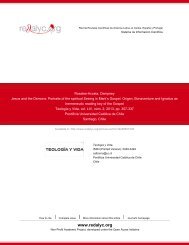A Key Concept in Modern Translation Theory - Redalyc
A Key Concept in Modern Translation Theory - Redalyc
A Key Concept in Modern Translation Theory - Redalyc
You also want an ePaper? Increase the reach of your titles
YUMPU automatically turns print PDFs into web optimized ePapers that Google loves.
72 EQUIVALENCE REVISITED: A KEY CONCEPT IN MODERN TRANSLATION THEORY<br />
Snell-Hornby 1986:12ff). Snell-Hornby s<strong>in</strong>gles out one particular dictionary entry,<br />
which supports her claim that equivalence basically equals identity and promptly proceeds<br />
to dismiss equivalence as ‘an illusion’ <strong>in</strong> translation studies. She writes that equivalence<br />
means ‘virtually the same th<strong>in</strong>g’. By contrast, I found the follow<strong>in</strong>g dictionary entries for<br />
‘equivalent’ and ‘equivalence’ <strong>in</strong> my own dictionary searches: ‘hav<strong>in</strong>g the same value,<br />
purpose… etc. as a person or th<strong>in</strong>g of a different k<strong>in</strong>d (Longman Dictionary of<br />
Contemporary English 1995), and ‘hav<strong>in</strong>g the same relative position or function;<br />
correspond<strong>in</strong>g…’ (Shorter Oxford English Dictionary 1993), as well as ‘equivalence is<br />
someth<strong>in</strong>g that has the same use or function as someth<strong>in</strong>g else’ (Coll<strong>in</strong>s Cobuild 1987).<br />
And <strong>in</strong> German, too, ‘Äquivalenz’ is not only a term <strong>in</strong> the ‘exakte Wissenschaften’ as<br />
Snell-Hornby claims: <strong>in</strong> my Brockhaus I read: ‘das was <strong>in</strong> gewissen Fällen gleiche Wirkung<br />
hervorzubr<strong>in</strong>gen vermag’. Such entries were not mentioned by Snell-Hornby as they<br />
would clearly not serve her purpose of discredit<strong>in</strong>g the concept of equivalence <strong>in</strong><br />
translation studies.” (p.26)<br />
It is evident that the objection presented by Snell-Hornby <strong>in</strong> relation to the<br />
use of the notion of equivalence <strong>in</strong> translation theory is not totally conv<strong>in</strong>c<strong>in</strong>g. In<br />
this respect we would say that “equivalence” <strong>in</strong> translation studies, as po<strong>in</strong>ted<br />
out by House, does not mean “identity” or “virtually the same th<strong>in</strong>g”. The fact<br />
that this is the mean<strong>in</strong>g this concept has traditionally been given <strong>in</strong> the so-called<br />
exact sciences does not entail that this very same mean<strong>in</strong>g should be ma<strong>in</strong>ta<strong>in</strong>ed<br />
when us<strong>in</strong>g the notion of equivalence <strong>in</strong> translation theory. In this case equivalence<br />
has to do more with “hav<strong>in</strong>g the same use or function as someth<strong>in</strong>g else”. To<br />
th<strong>in</strong>k of equivalence <strong>in</strong> terms of complete “identity” (e.g. as <strong>in</strong> mathematics)<br />
would be l<strong>in</strong>guistically rather naïve, to say the least, because languages are by<br />
def<strong>in</strong>ition different and complex l<strong>in</strong>guistic systems and, moreover, translation takes<br />
place not even between languages but texts embedded <strong>in</strong> complex communicative<br />
situations.<br />
On his part, Wolfram Wilss (1992), one of the most remarkable translation<br />
theorists, expresses his astonishment <strong>in</strong> relation to some authors’ refusal to<br />
acknowledge the usefulness of the notion of equivalence <strong>in</strong> translation studies as<br />
follows:<br />
“Thus I f<strong>in</strong>d it <strong>in</strong>comprehensible that recently the concept of translation<br />
equivalence has been so discredited (Snell-Hornby 1986; 1988). It is true that <strong>in</strong> the 70s<br />
the science of translation considered the concept of equivalence partially <strong>in</strong> a rigid and<br />
static way. But the reason why precisely the representatives of the functional-sociocultural<br />
translation approaches want to wipe out this notion puzzles me. And this because the<br />
modern science of translation, as repeatedly po<strong>in</strong>ted out, presents arguments by referr<strong>in</strong>g<br />
to texts and one cannot actually relate ST and TT but through a form of some micro- or
















